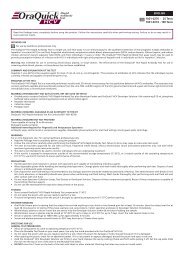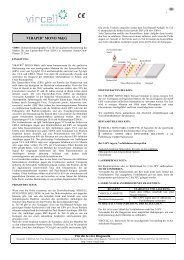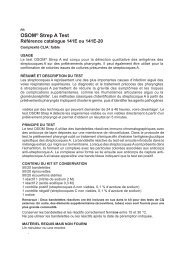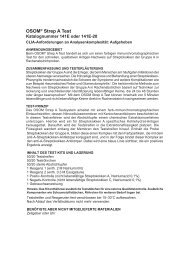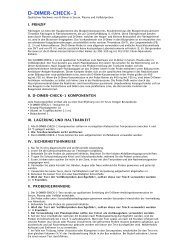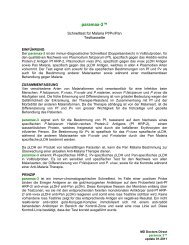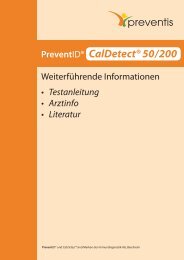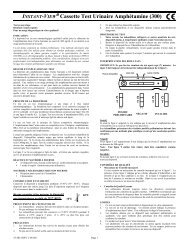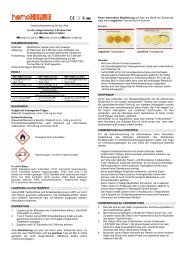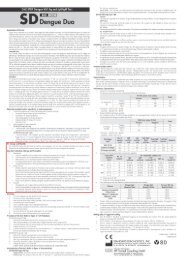Clearview Exact Strep A Cassette - MD Doctors Direct
Clearview Exact Strep A Cassette - MD Doctors Direct
Clearview Exact Strep A Cassette - MD Doctors Direct
Create successful ePaper yourself
Turn your PDF publications into a flip-book with our unique Google optimized e-Paper software.
ENGLISH<strong>Clearview</strong> <strong>Exact</strong> <strong>Strep</strong> A <strong>Cassette</strong>INTENDED USEThe <strong>Clearview</strong> <strong>Exact</strong> <strong>Strep</strong> A <strong>Cassette</strong> is a rapid test for the visual, qualitative detection of Group A <strong>Strep</strong>tococcalantigen directly from throat swabs. This test is intended for use as an aid in the diagnosis of Group A<strong>Strep</strong>tococcal infection and is for professional and laboratory use only.SUMMARYBeta-hemolytic Group A <strong>Strep</strong>tococcus is a major cause of upper respiratory infection such as tonsillitis,pharyngitis, and scarlet fever. Early diagnosis and treatment of Group A <strong>Strep</strong>tococcal pharyngitis has beenshown to reduce the severity of symptoms and further complications, such as rheumatic fever and glomerulonephritis(ref.2).Conventional methods used for the detection of the disease depend on the isolation and subsequent identificationof the organism (ref.2,5). These methods often require 24-48 hours to complete. Recent developments ofimmunological techniques (ref.1,3) which can detect Group A <strong>Strep</strong>tococcal antigen directly from throatswabs allow physicians to diagnose and administer therapy immediately.TEST PRINCIPLEThe <strong>Clearview</strong> <strong>Exact</strong> <strong>Strep</strong> A <strong>Cassette</strong> utilizes a two-site sandwich immunoassay technology for the detectionof Group A <strong>Strep</strong>tococcal antigen. The test consists of a membrane strip that has been precoated withrabbit anti-<strong>Strep</strong> A antibody and a colored rabbit anti-<strong>Strep</strong> A polyclonal antibody-colloid gold conjugate padthat is placed at the end of the membrane.During testing, the <strong>Strep</strong> A antigen is extracted from the throat swab using Extraction Reagents 1 and 2. Theextracted solution is then added to the cassette’s sample well. The <strong>Strep</strong> A antigen reacts with colored antibody-colloidalgold conjugate to form <strong>Strep</strong> A antigen-antibody complexes. The mixture then moves chromatographicallyacross the membrane to the immobilized rabbit anti-<strong>Strep</strong> A antibody at the test line region.If <strong>Strep</strong> A antigen is present in the specimen, a colored sandwich of antibody / <strong>Strep</strong> A antigen / gold conjugateantibody is formed on the test line. Absence of a colored line at the test line region indicates a negativeresult.Regardless of the presence of <strong>Strep</strong> A antigen, as the extracted mixture continues to move laterally acrossthe membrane to the control line region; a colored line at the control region will always appear. The presenceof this colored line serves as verification that sufficient volume has been added and proper flow occurred.REAGENTS AND MATERIALS SUPPLIED• 25 Individually pouched Test <strong>Cassette</strong>s.• Extraction Reagent 1 (12 mL): 5 M Sodium Nitrite.• Extraction Reagent 2 (12 mL): 0.03 M Citric Acid.• Positive Control (2 mL): Heat-killed Group A <strong>Strep</strong>tococcus in solution (1 x 10 8 organisms/mL) with0.1% sodium azide as a preservative• Negative Control (2 mL): Heat-killed Group B <strong>Strep</strong>tococcus in solution (1 x 10 8 organisms/mL) with0.1% sodium azide as a preservative.• 25 Extraction Tubes and Tips• 25 sterile polyester throat swabs.• One directional booklet.1
MATERIALS REQUIRED BUT NOT PROVIDED• Timing device.STORAGE AND STABILITYThe <strong>Clearview</strong> <strong>Strep</strong> A <strong>Exact</strong> <strong>Cassette</strong> should remain in sealed pouch and may be stored either refrigeratedor at room temperature 2˚-30˚C (36˚-86˚ F) until use or the expiration date printed on the kit box.PRECAUTIONS• For in vitro diagnostic use only.• For professional and laboratory use only.• Do not use after stated expiration date on the kit box.• Do not reuse the test.• Discard the test device if package is torn, ripped or if device itself is damaged.• Do not mix reagent or control bottle caps.• Do not mix reagents from different lots.• To obtain accurate results, the package insert instructions must be followed.• Standard guidelines for handling infectious agents and chemical reagents should be observed throughout all procedures. All contaminated waste, such as swabs, <strong>Clearview</strong> <strong>Exact</strong> <strong>Strep</strong> A <strong>Cassette</strong> devicesand extraction mixture should be properly disposed.• Extraction Reagents 1 and 2 are slightly caustic. Avoid contact with eyes or mucous membranes. Inthe event of accidental contact, wash area thoroughly with water.Positive and Negative Controls contain sodium azide which may react with lead or copper plumbingto form potentially explosive metal azides. When disposing of these solutions, always flush withcopious amounts of water to prevent azide build-up.• Caution: The controls contain potentially infectious components. No known test method can offer completeassurance that products derived from inactivated microorganisms will not transmit infection. It is recomendedthat the Controls be handled in accordance to appropriate biosafety practices, e.g., the OSHA BloodbornePathogen Standard, BSL-2 practices , etc. Handling precautions include, but are not limited to thefollowing:1. Wear gloves when handling specimens or reagents.2. Do not eat, drink, smoke, apply cosmetics, or handle contact lenses in areas where these materialsare handled.3. Clean and disinfect all spills of specimens or reagents using a tuberculocidal disinfectant such as 0.5%sodium hypochlorite, or other suitable disinfectant.4. Decontaminate and dispose of all specimens, controls and other potentially contaminated materialsin accordance with local, state and federal regulations.Reagent 1 contains sodium nitrite and is classified per applicable European Community (EC) <strong>Direct</strong>ive as: Toxic (T)and Dangerous for the environment (N). The following are the appropriate Risk (R) and Safety (S) phrases.R25 Toxic if swallowed.R50 Very toxic to aquatic organisms.S35 This material and its container must be disposed of in a safe way.S36/39 Wear suitable protective clothing and eye/face protection.S45 In case of accident or if you feel unwell, seek medical advice immediately (show the label where possible).S61 Avoid release to the environment. Refer to special instructions/safety data sheets.The Controls contain sodium azide and are classified per applicable European Community (EC) <strong>Direct</strong>ives as:Harmful (Xn). The following are the appropriate Risk (R) and Safety (S) phrases.R22 Harmful if swallowed.R32 Contact with acids liberates very toxic gas.S35 This material and its container must be disposed of in a safe way.S36 Wear suitable protective clothing.S46 if swallowed, seek medical advice immediately and show this container or label.2
SPECIMEN COLLECTION AND HANDLINGFollow standard clinical methods described by Facklam (Ref. 2) and Ross (Ref. 6). Use only polyester tippedsterile swabs with plastic shafts such as those provided. Do not use calcium alginate, cotton-tipped or woodenshafted swabs. To collect throat specimens, hold down the tongue with a depressor and rub the swab on thetonsils, or any areas of inflammation with signs of pus or redness in the back of the throat. Avoid touchingthe tongue or sides of the mouth with the swab.It is recommended that swab specimens be processed as soon as possible after collection. If swabs are notprocessed immediately they should be placed into a dry, sterile, and tightly sealed plastic tube for storage.Swab specimens can be stored at room temperature 15°-30°C (59°-86°F) for up to 4 hours or refrigerated2°-8°C (36°-46°F) for up to 24 hours. If a liquid transport method is employed, use Liquid Stuart’s TransportMedia or Liquid Amies Media as outlined in the manufacturer’s instructions. Do not use charcoal or agarmedia.If a bacterial culture is desired, gently streak the swab on a 5% sheep blood agar plate before testing withthe <strong>Clearview</strong> <strong>Exact</strong> <strong>Strep</strong> A <strong>Cassette</strong>. The Extraction Reagents kill the bacteria on the swab and make itimpossible to culture. Alternatively, a dual swab procedure or a subsequent second swab specimen may becollected for the culture.TEST PROCEDURE• Review “specimen collection” instructions. Test device, reagents, patient samples and controls must be atroom temperature 20˚- 30˚C (68˚- 86˚F) prior to testing. Do not open test packs until ready to perform theassay to avoid condensation of moisture on the membrane.• To avoid cross contamination, do not allow the tip of the reagent bottles to come in contact with throatswabs or extraction tubes.• Shake the Extraction Reagent and Control bottles before use.Reagent1Reagent21 minute<strong>Strep</strong> ACT1. Remove cassette from its protective pouch. If desired, label the cassette with patient or control identification.Place the cassette on a clean flat surface. Place the Extraction Tube in the designated area ofthe Workstation. Add 4 drops of Extraction Reagent 1 to the Extraction Tube. The reagent should bepurple-to-pink in color.2. Add 4 drops of Extraction Reagent 2 to the Extraction Tube. The solution should turn yellow in color.3. Place the throat swab specimen in the Extraction Tube. Rotate the swab inside the tube using a circularmotion to roll the side of the Extraction Tube so that liquid is expressed and reabsorbed from the swab.Let stand for a minimum of 1 minute. You may leave the Extraction Tube for up to 15 minutes at roomtemperature.4. Gently squeeze the swab firmly against the tube to expel as much liquid as possible from the swab.Discard the swab.5. Cap the Extraction Tube with the attached dropper. Then add all the extraction solution to the samplewell of the test device. Start the timing device.6. Read results in 5 minutes. Depending on the number of organisms on the swab, a positiveresult may be visible as soon as 1 minute. However, to confirm a negative result the complete reactiontime of 5 minutes is required. Do not read results after 10 minutes.3
C T C T C TC TPOSITIVE: Two pink colored lines appear. In addition to a pink colored line in the control region, a pink coloredline will also appear in the test region. The color intensities of the lines may vary. A positive result indicates thatthe specimen contains <strong>Strep</strong> A antigen.NEGATIVE: Only one pink colored line appears in the control region. No apparent pink colored line is visible in thetest region. A negative result indicates that there is no <strong>Strep</strong> A antigen in the swab sample or the <strong>Strep</strong> A antigenconcentration is below the detection level.INVALID: No colored line appears on the control region. Absence of the control line is an indication of a proceduralerror or possible reagent deterioration. Repeat the test with a new test device. If the problem persists,contact your local distributor.QUALITY CONTROLInternal Procedural ControlThe <strong>Clearview</strong> <strong>Exact</strong> <strong>Strep</strong> A <strong>Cassette</strong> has a built-in procedural control included in the test. The appearanceof a pink colored line appearing on the control region assures the correct test procedure was followed, indicatingsufficient volume of fluid was used and that capillary flow occurred. A clear background in the resultarea is considered an internal negative procedural control. If the reagents are working properly and the testhas been performed correctly, the background will clear to give a discernible result.External Quality ControlNegative Positive Invalid InvalidGood laboratory practice recommends the use of external controls to assure functionality of reagents andproper performance. Positive and Negative Controls are supplied in the kit. These controls are bacteriabased and tested like a patient sample. When testing with the controls, add 4 drops of Extraction 1 and 4drops of Extraction 2 to the Extraction Tube. Thoroughly mix the controls by shaking the bottle vigorously.Then add 1 drop of either the Positive or Negative Control to the tube. Place a sterile swab into the tube andswirl. Continue with Test Procedure Step 4.If the controls do not perform as expected, do not interpret the test results. Repeat test or contact your localdistributor.It is recommended that both a Positive and Negative Control be tested with every new test kit. However,every laboratory should follow their local and state quality control requirements.LIMITATIONSThe accuracy of the test depends on the quality of the swab sample. False negatives may result from impropersample collection or storage. A negative result may be obtained from patients at the onset of the disease dueto low antigen concentration. Therefore, when a patient suspected of having <strong>Strep</strong> A pharyngitis has a negative<strong>Clearview</strong> <strong>Exact</strong> <strong>Strep</strong> A <strong>Cassette</strong> result, additional testing using the culture method is recommended.The test does not differentiate asymptomatic carriers of Group A <strong>Strep</strong>tococcus from those with infection. Ifclinical signs and symptoms are not consistent with clinical test results, a follow-up throat culture is recommended.4
In rare cases, test specimens heavily colonized with Staphylococcus aureus can yield false positive results.If clinical signs and symptoms are not consistent with clinical test results, a follow-up culture procedureshould be performed.Respiratory infections, including pharyngitis, can be caused by <strong>Strep</strong>tococci from serogroups other thanGroup A, as well as by other pathogens.As with all diagnostic tests, a definitive clinical diagnosis should not be based on the results of a single test,but should only be made by a physician after all clinical and laboratory findings have been evaluated..It is not known how the test will perform in the presence of Fusobacterium necrophorum.EXPECTED RESULTSIt is estimated that approximately 19% of all upper respiratory tract infections are caused by Group A<strong>Strep</strong>tococci (ref.4). Infection is most prevalent in winter and early spring, with most cases arising in patientsliving in highly populated areas.PERFORMANCE CHARACTERISTICSDetectable LimitsTo determine the analytical sensitivity of the <strong>Clearview</strong> <strong>Exact</strong> <strong>Strep</strong> A <strong>Cassette</strong>, Group A <strong>Strep</strong>tococcus bacteriawere grown by standard culture techniques. The detection limit of the <strong>Clearview</strong> <strong>Exact</strong> <strong>Strep</strong> A <strong>Cassette</strong> wasdetermined to be 5 x 10 4 organisms/test.Correlation StudyA correlation study between the <strong>Clearview</strong> <strong>Exact</strong> <strong>Strep</strong> A <strong>Cassette</strong> and the conventional culture wasperformed in multi-center clinical evaluations. Throat swab specimens were taken from children and adultsexhibiting symptoms of pharyngitis. The swabs were then used to inoculate blood agar plates prior to testing withthe <strong>Clearview</strong> <strong>Exact</strong> <strong>Strep</strong> A <strong>Cassette</strong>. Beta-hemolytic colonies from the blood agar plates were confirmedas Group A <strong>Strep</strong>tococcus using serologic streptococcal grouping methods. <strong>Strep</strong> A was reported as presentor not present.The results are summarized in Table 1. Clinical Sensitivity and Specificity, and overall accuracy for<strong>Clearview</strong> <strong>Exact</strong> <strong>Strep</strong> A <strong>Cassette</strong> are calculated based on this data.TABLE 1<strong>Clearview</strong> <strong>Exact</strong><strong>Strep</strong> A <strong>Cassette</strong>Swab culturePositive Negative+ 99 2- 5 199Sensitivity = 99/104 = 95.2% (95% confidenceinterval = 92.8 - 99.4%)Specificity = 199/201 = 99.0% (95% confidenceinterval = 97.0-100%)Accuracy = 298/305 = 97.7%Site StudiesAn evaluation of <strong>Clearview</strong> <strong>Exact</strong> <strong>Strep</strong> A <strong>Cassette</strong> was conducted at three sites by laboratory personnelusing a panel of coded dried swab samples containing Negative Control (1 x 10 8 organisms/test Group Bstreptococcus), Low Positive (5 x10 4 organisms/test) and Positive (1.5 x 10 5 organisms/test) specimens. Atotal of one hundred thirty five 135 coded specimens were tested over a period of three days at three sites.Over 99% agreement with the expected results was obtained.5
Specificity StudyTo determine the specificity of the <strong>Clearview</strong> <strong>Exact</strong> <strong>Strep</strong> A <strong>Cassette</strong> to Group A <strong>Strep</strong>tococcal bacteria, variousGroup A <strong>Strep</strong>tococcal strains at different levels of organisms per test were examined. Positive resultsobtained at a level of 5x10 4 organisms/test for all strains indicated that <strong>Clearview</strong> <strong>Exact</strong> <strong>Strep</strong> A <strong>Cassette</strong>was sensitive to Group A <strong>Strep</strong>tococcal bacteria.Cross-reactivity studies with organisms likely to be found in the respiratory tract were also performed usingthe <strong>Clearview</strong> <strong>Exact</strong> <strong>Strep</strong> A <strong>Cassette</strong>. The following organisms were tested at 1 x 10 8 organisms/test.Group B <strong>Strep</strong>tococcus Candida albicansGroup C <strong>Strep</strong>tococcus Corynebacterium diphtheriaeGroup D <strong>Strep</strong>tococcus Escherichia coliGroup F <strong>Strep</strong>tococcus Haemophilus parahaemolyticusGroup G <strong>Strep</strong>tococcus Moraxella catarrhalis<strong>Strep</strong>tococcus agalactiae Neisseria gonorrhoeae<strong>Strep</strong>tococcus dysalactiae Neisseria lactamica<strong>Strep</strong>tococcus faecalis Neisseria meningitidis<strong>Strep</strong>tococcus faecium Neisseria sicca<strong>Strep</strong>tococcus oralis Neisseria subflava(formerly mitis)Proteus vulgaris<strong>Strep</strong>tococcus mutans Pseudomonas aeruginosa<strong>Strep</strong>tococcus pneumoniae Staphylococcus aureus<strong>Strep</strong>tococcus salivarius Staphylococcus epidermidis<strong>Strep</strong>tococcus sanguis Staphylococcus saprophyticusArcanobacterium haemolyticum Yersinia enterocoliticaBordetella pertussisStaphylococcus aureus was tested at a concentration of 1 x 10 7 organisms/test.Negative results were observed in all the above cases indicating the <strong>Clearview</strong> <strong>Exact</strong> <strong>Strep</strong> A <strong>Cassette</strong> is toGroup A <strong>Strep</strong>tococcal bacteria.6




